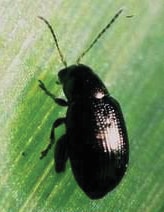

By Brian Kleinke
The corn flea beetle (Chaetocnema pulicaria) in high enough populations can be economically damaging to corn crops early in the growing season under the right environmental conditions. Feeding on dent, seed and sweet corn, this insect is consequently a concern for corn growers of all types.
The corn flea beetle is small (1/16th inches), black in color and possesses the ability to jump incredible distances from plant to plant. Adult corn flea beetles emerge in April and feed on grass and other weedy species until the desired host (corn) germinates and is established in the field. When feeding on corn, the flea beetle causes damage that can be described as “tracking.” Tracking is the appearance of gray to brown lines on the upper leaf surface that run parallel to the veins of the leaf. In heavy populations of corn flea beetles, the damage can give the corn’s foliage a silver
The time when corn flea beetle damage is of most concern for growers is between stages VE through V4. VE is the point of seed germination or emergence and V4 describes the fourth leaf stage of plant growth. Once the plant matures past the growth stage V4, the likelihood that the beetle will cause significant damage is low. Although, corn flea beetle feeding is often not noticed until the damage becomes quite severe and it is usually due to a combination of poor growing conditions and plant stress.
The real economical concern with heavy corn flea beetle infestations is the ability of the beetle to transmit a fungal disease known as Stewart’s Wilt (Erwina stewartii). The ability to forecast or predict the severity of corn flea beetle infestations and the potential for infection of Stewart’s Wilt was established in the 1930s by a man named N.E. Stevens. Some years later it was revised by G.H. Boewe.
The Stevens-Boewe system utilizes environmental information, specifically the average temperatures from the months of December, January and February, to gather a winter temperature index. A total from the three months is calculated (winter temperature index) and this index number is used to specify the level of expected corn flea beetle severity for the two stages of Stewart’s Wilt. According to the forecasting system with regard to Xenia, Ohio, which scored a 97 winter index temperature, this index indicates that beetles that survived the winter and are infected with the disease can spread a severe and destructive blow to corn growers planting susceptible varieties.
Prediction systems should be considered with some scrutiny as they do not take into account several variables that can influence the emergence of corn flea beetle nor do they take into account the infected plant material from the prior year or the beetles that fed on this material; however, this system has been accurate in past years.
To the benefit of corn growers, many hybrids have been produced that are resistance to Stewart’s Wilt and consequently make corn flea beetle feeding negligible. However, the feeding should still be monitored during years following mild winter conditions. The use of resistant corn hybrids or seed that is treated with insecticide to guard against corn flea beetle is the most commonly used practices to avoid economic hardships. Although, if a susceptible variety has been planted in the field, it would be advised to regularly scout for damaged plants and the presence of the beetle in order to establish the best management of the pest.
For more information or to discuss specifics of the Corn Flea Beetle or Stewart’s Wilt, contact Brian Kleinke at the Greene County OSU Extension office at 937-372-9971 ext. 114 or by email at [email protected].



